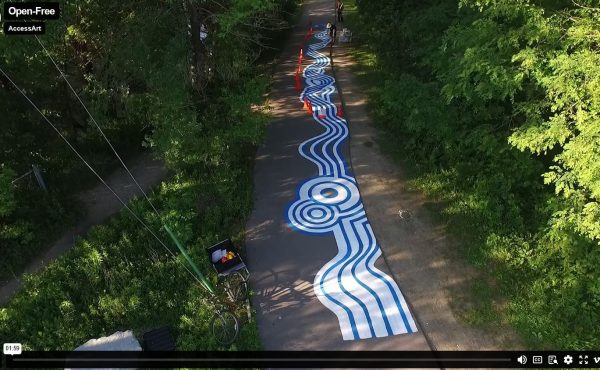
“We’re not here to ask if it’s a good idea if urbanism and transit are related,” said Paul Goldberger, author and architecture critic for The New Yorker, in his keynote speech at the Canadian Urban Institutes Designing Transit Cities Symposium. It becomes quite clear over the two day event, that the success of a public transit focused city is inexplicably linked to the success of its urban fabric. The symposium asked questions about appropriately scaled development along transit lines, including public transit in the design of beautiful streetscapes and gaining public support for transit-based cities.
Although the focus was for creating cities that are designed around public transportation, “denying the automobile is not going to be the route for transit cities over the long haul,” Goldberger makes clear, “but if you do it right, it can improve the cities for those that don’t drive.” However, “cars, when the only game in town, make decent urban design impossible.” He also states, “doing the right thing in a larger conceptual way, is not in and of itself,” with respects to the Gardiner Expressway, it is not enough to simply remove the highway, it needs to be replaced with a well thought out piece of urban design, such as the Rose Fitzgerald Kennedy Greenway in Boston. Goldberger spoke about the importance of transit being linked to other transit and the balance of the planned and un-planned within a city, allowing for serendipity.
Robert Cervero, author, consultant and director of the Institute of Urban and Regional Development at the University of California at Berkeley, spoke about a number of European transit-friendly cities, such as Zurich and Stockholm. Although not a big city, Zurich is one of the most transit friendly, with an average of 600 public transit trips per person per year and a ridership of 62%. Their transit system includes signal prioritization (increased green signals into the city during peak times), bike traffic signals, zonal tariffs, transit integration and car sharing. As Cervero says, all these elements, “blow away notion that transit is a second class form of transportation.” In Stockholm, they put a high importance on station and corridor planning, helping them build their rail system in advance of demand. While Stockholm is known for its great public transportation system, it is not an anti-car city, Cervero explains, “they own cars, but just judicious about when they use them.”
According to Mariia Zimmerman, VP of Policy at Reconnecting America, the key to creating good transit cities is, “everyone needs to be an advocate for better design.” She urged attendees to think about how transportation funds can be used beyond transit projects, such as for community development, and to make sure suburban regions were really ready for transit development, with supportive infrastructure around them, like employment opportunities and services, stating, “it’s easier for jobs to move than for houses to move.”
The theme that seemed to surface the most, was the holistic approach we need to take regarding designing transit cities. G.B Arrington, senior practitioner and practice leader for PlaceMaking at Parson Brinckerhoff, urges Toronto “to not be a transit city, but to be a transit region.” There was much discussion on how to create a sense of urban in the suburbs, by thinking more broadly about the area around the transit lines and stations, activating street edges and the public realm. “It’s easy to focus on what’s happening at the centre,” states Arrington, “but just as important to look at what’s happening on the edge.” There was also agreement on the importance of good street design, as Goldberger says, “in an effective city, the street means more than the buildings.”
What I found most interesting was how little discussion there was on actual modes of transportation, showing the significance and importance of the urban design that surrounds it. Transit alone does not make a successful transit city, but paired with good infrastructure, effective street design and inviting public spaces, both systems will boost each other.
Image by WATERFRONToronto




14 comments
When so much of our built environment in this region was designed in a way that inherently inimical to transit, well, good luck turning anything into much of a transit city/region.
That picture is sexy I hope it looks like that before we get the Olympics or the leafs win a cup.
Would Goldberger’s “well thought out piece of urban design” ideal allow for retention rather than replacement of the Gardiner? (Just thinking of various alternative schemes to “creatively” retain it.)
The Big Dig is a great piece of urban design. It also cost 22 billion dollars.
I already know this will be such a popular opinion (/sarcasm), but I think the focus should be on building communities that are not car dependent. This does not mean creating “car vs bike” conflicts or condemning drivers and making driving as difficult as possible. It means making it so that one can walk to most all of their needs just as easily – if not more so – than to drive since they are all located centrally.
It also means that if one needs to drive (most likely to destinations outside this central core), they can do so easily.
But in the end, on a planet with finite resources and where pollution enters a closed loop, we do have to get rid of cars, even if it only happens once we have sacrificed everything to retain them.
Toronto’s transit strategy is a relic of 1940s thinking that, luckily, managed to come back into style after the 1970s and served the growing city fairly well. However, as pointed out above, it needs a major regional overhaul. Tokens, too-slow streetcars and a subway being (ab)used for 905 commuter rail rather than built into a 416 net will not cut it in future decades. Necessary steps:
– Turn Metrolinx into the actual operating and funding authority for all regional transit systems. Its board should be dominated by the 416 to ensure a focus on serving the city (the economic engine), but it should take over from TTC, GO and all others.
– Multimodal is no longer about subway-streetcar-bus. It’s about commuter rail-subway, and parking lot-commuter rail, and bike-bus-ferry and every other combination. You have to make schedules and fares mesh for all transit across the entire GTA. Presto is a start, but needs to be brought on full force.
– Tolls, gas taxes and other fees need to be implemented and aligned in a systematic way that appropriately incentivizes transit without unduly punishing those who do not have options
– Electrify GO and run it all day, every hour at a minimum
– Take all the little steps, from fare payment to stop placement to parking regulations to speed up streetcars and turn a not-even-on-the-subway-map streetcar web into actual other-cities-would-die-for-this rapid transit LRT.
– Tax the whole region, right out to beyond the last stop on GO, to ensure that businesses do not go tax-shopping (a perfectly rational choice, but with bad overall results) to avoid the payroll, sales and other taxes that will be needed to fund regional transit. Toronto has been suffering from this for years and it needs to stop.
Etc, etc. Sigh.
Mariia Zimmerman makes a very good point. Transit for the sake of transit makes little sense. It must be serving the origin:destination relationship. That is what worries me about the large investment in Transit City. Take a look at the Finch line. It runs through wards 1, 7, 8, 10, and 23. Between 1991 and 2001 the number of residents living in those wards whom travelled outside the city for employment increased by approx. 20,000. Between 1989 and 2004 (while the rest of the country/province was growing) they had a cumulative net loss of 426 jobs. Three of the five wards lost population.
iSkyscraper: Yes, that would be the thing to do. But have a listen-in on Question Period today at Queen’s Park and observe the sh*t fit being thrown over the comparatively (IMHO) minor changes involved in implementing the HST. The tax changes required to fund your (and my) transit wishlist — let alone the governance issues involved in getting the region(s) to play nicely with metrolinx handling operations given the perpetual 905/416 mutual hate-fest — require considerably more political will than anyone’s been able to muster lately.
This nascent TTC Riders Union needs to become a GTA Transit Riders Union… and it needs to be much deeper (and less populist) than a reflexive fare revolt.
Greg Smith: I wouldn’t be too quick to draw parallels between HST and new taxes for transit. The HST is a populist issue that the Conservatives can ride in a bid to connect with voters. If people take note of a good plan to improve transit in the region substantially, it’ll be harder for the opposition to play the “tax grab” game.
iSkyscraper is right on!
And Ben Smith makes a key point. While the old City of Toronto has people working, playing and shopping all within walking distance of where they live, in most of the GTA this is not the case. You get miles and miles of houses, with nary a store or office to be found. With an urban fabric like that, it’s nearly impossible to get people out of their cars.
What is needed is a two prong approach – build better transit, because it’s needed now. And at the same time, build a more pedestrian/transit friendly urban environment. Experience has shown that the former is usually a catalyst for the latter.
I’d just like to point out that Goldberger did not say that the Rose Fitzgerald Kennedy Greenway was a well though out piece of urban design, in fact he said it was a banal, insipid and a “green scar”, if I recall his words correctly. You are quite correct in that he said it was not enough to simply remove the highway, but he was using the linear park in Boston as an example of exactly what not to do.
Laurie,
The problem is that one of those prongs is bent. It is uneconomical to build non residential space in most parts of the city. Despite any wishes and planning, unless the the environment is conducive, nothing but residential will get built. Save for some menial ground floor retail.
One thing that I would seriously consider looking into doing is shifting TTC fares from the fare box to propertt tax. Maybe even move the entire burden with transit free for residents of the city and fares (based by distance) for non city residents. A back of the napkin calculation works out to ~$900 per household needed to replace operating revenues. If non residents make up 30% of riders, this revenue would be able to make up the shortfall (which appears in the city’s operating budget).
I think it´s not only the topologic planing of the traffic system – it´s also the question about “green transportation systems”. The sad fact is that governments and businesses have designed our infrastructure so that we will be largely dependent on the private automobile. Urban sprawl, scattering the services away from residential areas, lack of bicycle pathways, poor public transportation, destruction of railway tracks and transportation corridors, and the heavy tax-payer subsidisation of the roadways (to name some of the factors) have resulted in very poorly designed cities and transportation networks.